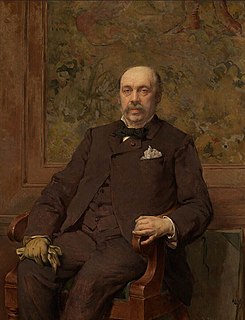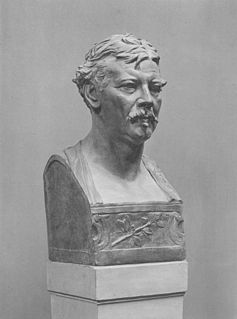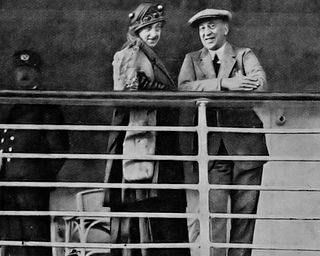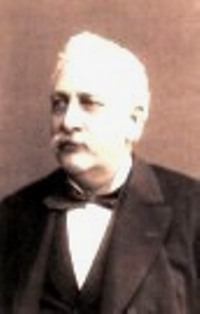
Louis Marie-Anne Couperus was a Dutch novelist and poet. His oeuvre contains a wide variety of genres: lyric poetry, psychological and historical novels, novellas, short stories, fairy tales, feuilletons and sketches. Couperus is considered to be one of the foremost figures in Dutch literature. In 1923, he was awarded the Tollensprijs.
Dutch-language literature comprises all writings of literary merit written through the ages in the Dutch language, a language which currently has around 23 million native speakers. Dutch-language literature is the produce of Netherlands, Belgium, Suriname, the Netherlands Antilles and of formerly Dutch-speaking regions, such as French Flanders, South Africa, and Indonesia. The Dutch East Indies, as Indonesia was called under Dutch colonization, spawned a separate subsection in Dutch-language literature. Conversely, Dutch-language literature sometimes was and is produced by people originally from abroad who came to live in Dutch-speaking regions, such as Anne Frank and Kader Abdolah. In its earliest stages, Dutch-language literature is defined as those pieces of literary merit written in one of the Dutch dialects of the Low Countries. Before the 17th century, there was no unified standard language; the dialects that are considered Dutch evolved from Old Frankish. A separate Afrikaans literature started to emerge during the 19th century, and it shares the same literary roots as contemporary Dutch, as Afrikaans evolved from 17th-century Dutch. The term Dutch literature may either indicate in a narrow sense literature from the Netherlands, or alternatively Dutch-language literature.

The Potato Eaters is an oil painting by Dutch artist Vincent van Gogh painted in April 1885 in Nuenen, Netherlands. It is in the Van Gogh Museum in Amsterdam. The original oil sketch of the painting is at the Kröller-Müller Museum in Otterlo, and he also made lithographs of the image, which are held in collections including the Museum of Modern Art in New York City. The painting is considered to be one of Van Gogh's masterpieces.

Willem Johannes Theodorus Kloos was a nineteenth-century Dutch poet and literary critic. He was one of the prominent figures of the Movement of Eighty and became editor in chief of De Nieuwe Gids after the editorial fracture in 1893. He was nominated for the Nobel Prize in Literature five times.

The Tachtigers ("Eightiers"), otherwise known as the Movement of Eighty, were a radical and influential group of Dutch writers who developed a new approach in 19th-century Dutch literature. They interacted and worked together in Amsterdam from the 1880s. Many of them are still widely read today.

Frederik Willem van Eeden was a late 19th-century and early 20th-century Dutch writer and psychiatrist. He was a leading member of the Tachtigers and the Significs Group, and had top billing among the editors of De Nieuwe Gids during its celebrated first few years of publication, starting in 1885.

Jean-François Portaels or Jan Portaels was a Belgian painter of genre scenes, biblical stories, landscapes, portraits and orientalist subjects. He was also a teacher and director of the Academy of Fine Arts of Ghent and the Académie Royale des Beaux-Arts in Brussels. He is regarded as the founder of the Belgian Orientalist school. He was praised in his time as the premier painter of 'everyday elegance and feminine grace'. Through his art, teaching and his leadership of the Académie Royale in Brussels he exerted an important influence on the next generation of Belgian artists, including his pupil Théo van Rysselberghe.

Gustaaf Adolf Frederik Molengraaff was a Dutch geologist, biologist and explorer. He became an authority on the geology of South Africa and the Dutch East Indies.
De Nieuwe Gids was a Dutch illustrated literary periodical which was published from 1885 to 1943. It played an important role in promoting the literary movement of the 1880s. Its contents covered a wide range of topics, extending to developments in science.

Marius Alexander Jacques Bauer was a Dutch painter, etcher and lithographer, best known for his Oriental scenes. His style was largely Impressionistic, although it also derived to some extent from the Hague School. Many of his works were based on photographs he bought during his travels, some of which were by famous photographers such as Félix Bonfils.

Peasant Character Studies is a series of works that Vincent van Gogh made between 1881 and 1885.

Still life paintings by Vincent van Gogh (Netherlands) is the subject of many drawings, sketches and paintings made during Vincent van Gogh's early artistic career. Most still lifes made in the Netherlands are dated from 1884 to 1885, when he lived in Nuenen. His works were often in somber colors. Van Gogh experimented with the use of light falling across objects.

Leopold Carl Müller was an Austrian genre painter noted for his Orientalist works.

August Allebé (1838–1927) was a 19th-century artist and teacher from the Northern Netherlands. His early paintings were in a romantic style, but in his later work he was an exponent of realism and impressionism. He was a major initiator and promoter of Amsterdam Impressionism, the artist's association St. Lucas, and the movement of the Amsterdamse Joffers. Amsterdam Impressionism – sometimes referred to by art historians as the School of Allebé – was the counterflow to the very strong Hague School in the movement of Dutch Impressionism. As a professor at the Royal Academy of Amsterdam he fostered a cosmopolitan attitude toward art and the promotion and motivation of his students, and provided a significant stimulus to developments in modern art.

Cornelis Marinus Pleyte was a Dutch museum curator, Dutch East Indies subject-matter expert, teacher, and author. He was notable for his classification work on neolithic Indonesian adzes.
Caroline Anne Freiin de Westenholz is a Dutch art historian. She is the founder of the Louis Couperus Museum in The Hague.

Elisabeth Wilhelmina Johanna (Betty) Couperus-Baud, was a Dutch translator. She was the wife of the Dutch writer Louis Couperus (1863–1923).

John Ricus Couperus was a Dutch lawyer, member of the Council of Justice in Padang, member of the High Military Court of the Dutch East Indies and the landheer of Tjikopo. He was also the father of the Dutch writer Louis Couperus and knight in the Order of the Netherlands Lion.

Orchids, a collection of prose and poetry is a collection of prose and poetry written by Dutch writer Louis Couperus, which was published in 1886. Couperus published his debut, A ribbon of poems in 1886 with publisher J.L. Beijers. The rights to publish Couperus' books were taken over by publisher A. Rössing, who then published the second book of Couperus, Orchids, a collection of prose and poetry. After Rössing filed for bankruptcy in 1890 the rights were taken over by L.J. Veen, who would publish the second edition in 1895. In 1989 Veen would reprint Orchids, when Couperus' complete works were published.

Ecstasy: A Study of Happiness is a novel written by Louis Couperus and published in 1892 by L.J. Veen in a first edition of 1,250–1,500 copies. A second edition was printed in 1894 and a third in 1905. Ecstasy was the first book of Couperus that was published by L.J. Veen, later his regular publisher. Couperus received a wage of 550 guilders for the first edition. Ecstasy was first published in the Dutch literary magazine The Gids. The book was translated into English by Alexander Teixeira de Mattos in 1919 and published by Dodd, Mead and Company.



















